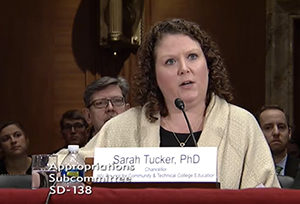As education leaders await to see what President Donald Trump’s proposed budget holds, supporters of year-round Pell grants argue that reinstating them would not only be an investment in students, but also an investment in workforce and economic development.
During a Senate appropriations subcommittee hearing on Wednesday, community college advocates stressed the importance of reinstating year-round Pell so students can also use the federal aid during the summer. In many areas, dislocated workers look to community colleges to attain new stills or for upgrades, and employers seeking qualified workers are eager to board them. But not being able to tap Pell grants year-round can force workers and employers to wait.
“People are not laid off on a semester-by-semester basis,” said Sarah Tucker, chancellor of the West Virginia Community and Technical College System, adding later: “Try to have a conversation with an employer about why we can’t keep a training program during the summer time so that they can hire people.”
Sen. Roy Blunt, chair the Senate appropriations panel on education and labor, indicated his support for year-round Pell as it “will be critical for students pursuing STEM degrees and careers, particularly those at community colleges.” His subcommittee last year recommended reinstating year-round Pell, which is also supported by the American Association of Community Colleges and other two-year college advocates.
Making a difference
Tucker also emphasized the importance of job training grants, especially to help displaced coal miners in West Virginia transition to new careers. The four largest-growing industries in her state are manufacturing, health care, information technology and energy — all STEM areas, she said.
New River Community and Technical College used federal emergency dislocated worker training grants to allow unemployed coal miners to enroll in its 14-week electrical distribution engineering technology program. Last August, 32 former miners, oil and gas workers, and others finished the program, Tucker said in her testimony.
STEM programs require a partnership among colleges, employers and other stakeholders, including K-12 systems, Tucker said. She highlighted for the subcommittee a partnership between BridgeValley Community and Technical College and Toyota Motor Corp. In 2012, the college launched an advanced manufacturing technician associate degree that includes a paid work experience at Toyota. The program has worked so well that the car manufacturer has since donated state-of-the-art robots for training, as well $1 million to maintain the college’s advanced technology center, known as the Toyota Center.

Sarah Tucker, chancellor of the West Virginia Community and Technical College System, speaks at a Senate appropriations subcommittee on STEM education.
On the horizon, Blue Ridge Community and Technical College is poised to work with Procter and Gamble, which recently moved to West Virginia and will need to hire more than 700 employees over the next three years — each trained in STEM-related fields such as mechatronics, instrumentation process controls and applied lab technicians. However, a steady pipeline of prospective employees is needed, so it’s important to work with K-12 to spark students’ interest in STEM careers.
“These pipelines are desperately needed between K-12 and community colleges to help them ensure that students come to us well prepared for the coursework in front of them,” Tucker said in her testimony.
An economic angle
Several members of the subcommittee noted the importance of STEM not only in providing jobs but in helping the U.S. remain globally competitive. Sen. Marco Rubio, R-Florida, said STEM lessons should be integrated more broadly into K-12 education — though he added he is not calling for any mandates — while Sen. Jeanne Shaheen, D-New Hampshire, cited that her state will need 43,000 STEM workers by 2018 to fill available jobs.
“It’s a real challenge and one we have to meet in order to stay competitive in the 21st century,” she said.
Community colleges have made significant strides in preparing students for STEM-related careers, especially through programs at the National Science Foundation and NASA, Tucker said. And while it appears unlikely Trump will propose more funding for education — in fact, significant cuts are expected — broadening eligibility for some grants to allow community colleges to participate could help their STEM education and training efforts, she said.

